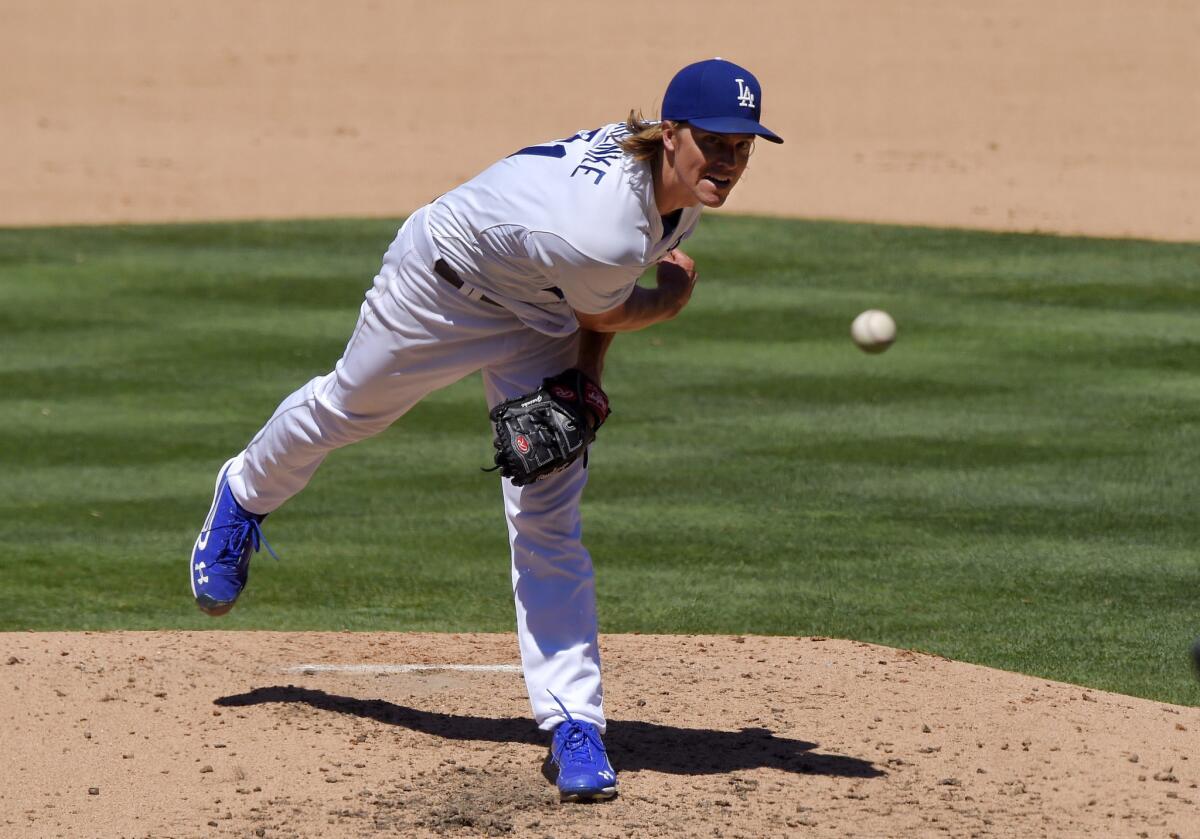Every pitch counts in baseball, but the 1-1 pitch counts more than any other

Dodgers starting pitcher Zack Greinke knows the importance that goes into every pitch and how one ball or strike call alters an entire at-bat.
- Share via
Dodgers right-hander Zack Greinke has a reputation for being among the most cerebral pitchers in baseball, and when he leans in for the sign, his mind runs a quick scan through scores of numbers, memories and situational factors.
“So many things come into play,” he says. “You’ve got to weigh what type of hitter it is up to bat, what pitches are working that day, who’s up to bat next, what inning, what’s the score, if there’s guys on base, if there’s guys not on base, what type of park you’re in, if the ball’s carrying that day. And that’s probably just the beginning.”
How his arm feels, what the umpire’s strike zone looks like, what a hitter has done against Greinke in the past — even seasons ago — and whether he looks like he’s sitting on a certain pitch are among other considerations.
And the calculus becomes even more complicated in a specific count: one ball and one strike.
The general consensus in baseball has long held that the first pitch of an at-bat is the most important. The logic: getting ahead in a count will lead to better results.
But advanced analytics show the 1-1 count actually is most likely to be an at-bat’s turning point, and teams like the Dodgers, whose front office is constantly probing for even the slimmest of edges, are trying to leverage the count to their advantage.
“We, organizationally, are stressing what pitchers and what hitters can control versus what things are out of their control,” says Gabe Kapler, the team’s director of player development.
Pitchers have at least partial control over whether they throw a strike with the count at 1-1. This year, the Dodgers began using 1-1 strike percentage to help choose the organization’s pitcher of the month.
For every pitcher in their minor league system, Kapler says, “if he’s not executing enough strikes in a 1-1 count, we can use that to start a discussion of how much better he might be if he was perhaps more assertive in that count versus maybe trying to make the perfect pitch.”
The idea has been used before. In the 2003 book “Moneyball: The Art of Winning an Unfair Game,” Paul DePodesta, then in the Oakland Athletics’ front office, describes hitters with a 1-2 count as scrubs and hitters at 2-1 as “all-stars.”
DePodesta, a Harvard graduate in economics who was the Dodgers’ general manager in 2004 and ’05 and now works in the New York Mets’ front office, based that opinion on numbers — and statistics this season indicate not much has changed. Through Sunday, major league hitters this season were batting .169 when the count is 1-2 compared to .342 on a 2-1 count — the biggest single-pitch difference in any count.
Thirty-nine percent of all at-bats go to 1-1, meaning there are dozens of mini-crossroads in each game.
“If you have even five 1-1 counts in a game, and you turn them all into 2-1 counts, you’ve just put five hitters . . . in a really good position,” Angels Manager Mike Scioscia says. “We call it an action line of a pitcher, what pitches you have available, what counts and where you want to use them. That 1-1 count is the most intriguing because it’s the biggest swing count. If you look at just the difference between 1-2 counts and 2-1 counts, it’s staggering.”
But ask how the Angels use that information to determine pitch selection and Scioscia turns cagey. Hitters, knowing that information, could use it to their advantage, he says.
Angels right-hander Huston Street has been one of the most consistent closers in the past decade despite a fastball that never climbed out of the low 90s. He has been effective, he says, because he knows when to throw strikes and when to nibble.
Street believes the first pitch is the most important, noting that if he throws a strike, then he has to throw only one more strike in the next two pitches to put the batter in a 1-2 hole. But, he says, the 1-1 count is more complex because hitters become more dangerous the more pitches they see. The deeper a count goes, the more careful a pitcher has to be.
“To me, I totally agree with the numbers,” Street says, “1-1, I do think that at the end of the day, that is the most pivotal pitch in an at bat.”
Greinke notes that, with the long list of factors that goes into his pitch selection at a 1-1 count, nothing is a given.
“Depending on the batter,” he says, “you might throw a ball on purpose,” thinking that a batter anticipating a strike might chase.
A pitcher’s approach might also depend on how lively his arm is. For example, Street has to be more careful than many closers because he uses deception more than power.
Angels right-hander Garrett Richards says he studies other pitchers’ sequences when he is not pitching. But before his own starts, Richards’ preparation consists only of a brief rundown of the opposing lineup.
His stuff is sharp enough, and he has enough confidence in his secondary pitches, that his overriding goal is always the same: stay ahead in a count. And, he says, “1-1 is kind of that tipping point.”
Hitters can try to work a count, too, but they can’t control strikes or balls. Often, they can only react.
Mike Trout says he is unaware what his batting average is in different counts.
“I just go up there and try to square up a ball,” he says.
He doesn’t know it, but he’s much more likely to do that after taking a 1-1 ball.
His career batting average at 2-1 counts? .459.
More to Read
Go beyond the scoreboard
Get the latest on L.A.'s teams in the daily Sports Report newsletter.
You may occasionally receive promotional content from the Los Angeles Times.











